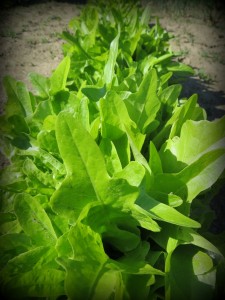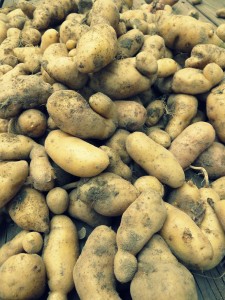Every year I operate a seasonal market garden. I sell vegetables, fruit, nuts and value-added products directly to customers. My market garden plan is ever-evolving based on what is most profitable, least labor intensive and most cost effective to produce.
There is no magic formula for market garden profitability. Local tastes and market channels should always be your main consideration. But trial and error has taught me a great deal about turning a profit on a small amount of acreage. Modifying my market garden plan to include more moneymakers and less labor intensive items has made my small farm more efficient and profitable.
At the end of each season I sit down and review sales records to identify my top sellers. I recall which crops took most of my time and effort that season. I assess cost inputs such as seed, specialty fertilizer, plant supports and mulch. After a thorough review I have identified my high and low value crops.
Top 3 high value crops
1. Heirloom tomatoes with their odd shapes, unique colors and distinct flavors catch shoppers’ eyes and tempt their taste buds. Market shoppers don’t mind paying premium for something they can’t buy in stores.
2. Squash and pumpkins are a big hit for fall decorating and baking. Most cucurbits take over 100 days to mature, but they are the least labor intensive crops I grow. Squash and pumpkins are also easy to transport to market and have a long shelf life.

3. Salad greens are inexpensive to produce and sell well at market. Shoppers appreciate organic fresh picked salads. Unfortunately salad greens are very difficult to transport to market, and begin to wilt upon arrival.
A fellow farmer with more production acreage told me “Sweet corn keeps my farm stand afloat.” He said it is his top seller every season. He also said berries are a very profitable perennial crop for his farm. Overripe and unsold berries can also be turned into value-added preserves before they go to waste, but more on adding value later.
Bottom 3 low value crops
1. Potatoes are not a profitable market crop, likely due to the fact shoppers can buy 5 lbs at the grocery store for around $3. I discovered an exception: heirloom fingerling, blue colored potatoes and purple sweet potatoes have eye appeal that sell themselves at market.

2. Turnips do not sell. They also do not keep as well as other root crops: carrots, beets and radishes.
3. Bulb onions are a low value crop. Though not labor intensive to grow, full sized onion bulbs take a long time to mature. Like standard potatoes, traditional bulb onions can be bought very cheap at the grocery store. The exception is scallions, or green onions, which sell very well at market. They mature much faster than bulb onions. Scallions are a cool season crop that can be grown to bring a profit twice a year, in early spring and again in fall.
Adding value
I don’t cut a crop out of the market garden completely just because it doesn’t make the high value cut. Some crops earn a place in my market garden by other means. Peppers aren’t big moneymakers, but my Sweet n’ Hot Pepper Preserves value-added product is. A little creativity turned my low value gourds into value-added bird houses. I add value to my garlic crop by turning too-small bulbs and bulbs damaged during harvest into garlic salt and minced garlic. Seasonings are very popular market products.
I’ve found adding value through processing is a good way to increase profits and keep my market stand full all season long.














I agree that regular white potatoes are not highly profitable unless you stress the fact that they are grown without chemicals. “store bought” are one of the dirty dozen as commercial growers use lots of fert and herbicide and the skin holds it. Medium sized red skins and “all natural” yukons can bring a premium. Also, various carrot types especially multi colors and radishes such as french breakfast and cherry bell and then the white icicle radish in the fall.
It is great to see an article that focuses on profitability in market farming. I would offer that the scale of the farm, your customer base, growing practices, labor system, etc can switch things up drastically. I have a 1.5 acre organic mkt farm. Because of my organic certification, and because I’ve found “specialty” varieties that do well for me, I find that non-fingerling potatoes and bulb onions to be two of my best crops for productivity and profitability. They store well, look great at mkt because of their color and variety, don’t require much prep work, and are items that my customers use regularly. I get 3/lb for both (which does reflect an urban, organic focused mkt price). Items like sweet corn, winter squash and melons aren’t particularly profitable for me because they require much more land than I have and are more vulnerable to pest damage. Salad and leafy greens are also good sellers for me, but harvesting and prepping salad greens well can be incredibly labor intensive. If you don’t have a good system in place for quality, harvest, prep and pack this crop can turn from a money maker to a labor-devouring time suck. One last thought: in my area there has been a huge glut of heirloom tomatoes for the past few seasons. Before deciding that these will be money-makers, check out mkts late in the day, mid season and see if other heirloom tomato producers are successfully selling their tomatoes and what varieties and looks are still sitting on the table.